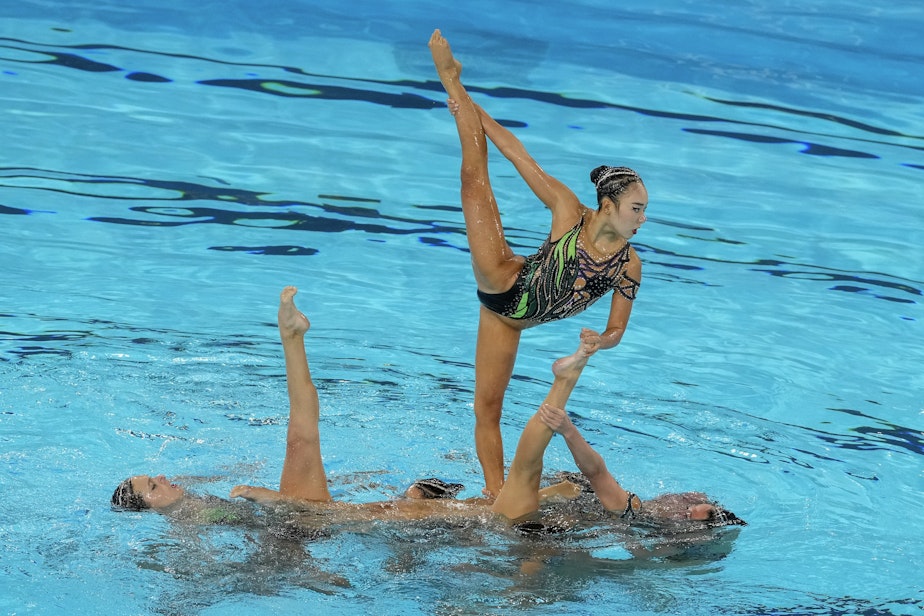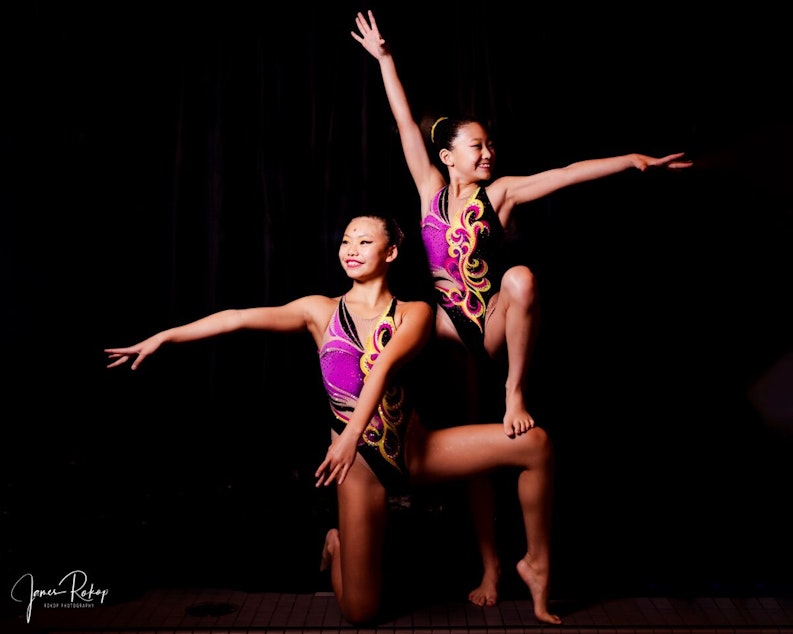Seattle-trained synchronized swimmers take silver at Paris Olympics

Two members of the U.S. artistic swim team that won a silver medal at the Paris Olympics Wednesday got their start in what was formerly known as synchronized swimming with Seattle Synchro.
The nine-member U.S. team, which finished second to China, includes Keana Hunter and Audrey Kwon.
It was the first time in 16 years the U.S. team qualified for the Olympics in synchronized swimming. The competition was notable for the absence of the traditionally dominant Russian team, which had won every gold medal in the sport dating back to the 2000 Olympics in Sydney, Australia. Russian athletes were banned from competing in this year's games, though some are competing as “Individual Neutral Athletes.”
RELATED: UW rowers win record 11 medals at Paris Olympics
The name change, from “synchro” to “artistic,” comes with a change in style and substance for the transforming Olympic sport. While the smiles, makeup, and hair gel remain, the water ballet of previous Olympics has become much more acrobatic and athletic, placing greater emphasis on power, endurance, and energy.
Sponsored

“This is an absolutely different sport,” said Adam Andrasko, who heads USA Artistic Swimming.
The final “acrobatic routines” follow technical and free routines and include seven “above-water” elements. That means that seven times during a routine, a swimmer or “flier” is launched by the other members of the team six feet in the air to perform twists, flips, and dives.
Rules have also changed about how the competition is judged and certain moves are rated with a level of difficulty as part of the scoring, similar to gymnastics, figure skating, and diving.

Keana Hunter and Audrey Kwon got their start traveling from pool to pool, rain or shine, with Seattle Synchro.
Head coach and club owner Daniela Garmendia said the swimmers make the performance look easy, but executing challenging moves in sync with others, while exerting yourself and holding your breath makes artistic swimming an incredible mental and physical challenge.
“Imagine sprinting a mile and then hold your breath,” Garmendia said. “You are pushing your body to maximum capacity of effort in absence of oxygen.”
The sport — which combines elements of swimming, gymnastics, ballet, diving, and cheerleading — also requires members of the team to remain in perfect harmony and timing with those around them.
RELATED: Inspired by the Olympics? It’s not too late to ignite your own fitness journey
Sponsored
“The mental challenge is a little crazy,” Garmendia said. “We try to do highly technical skills in an artistic way.”
Garmendia said both Hunter and Kwon had to relocate to California to complete their Olympic training because of a lack of dedicated pool space in the Seattle area.
“Our club is always hunting for pools,” Garmendia said. “The team moves around a lot. It’s not only the pool that changes. It’s the schedule that changes.”
That can make artistic swimming a challenging pursuit for children and their parents.

Despite those challenges, two 11-year-old members of Seattle Synchro, Siran Cao and Isabella Lin, are practicing to represent Team USA later this month at the PanAm Artistic Swimming Championships in Lima, Peru.
Another new addition to artistic swimming this year — men.
This is the first year men had the opportunity to compete in the Olympic event, but no men were picked by any of the teams.
RELATED: Olympic update: Wrestling rumbles and track triumphs
But the trend to include males is already making waves at Seattle Synchro.
Sponsored
A Seattle Synchro swimmer named Ethan Yu won silver at the junior championships in 2023.
On the Olympic level, organizers are considering the addition of a mixed duet event at the 2028 summer games in Los Angeles.
Tap here to listen to the full Soundside story on Seattle Synchro.





